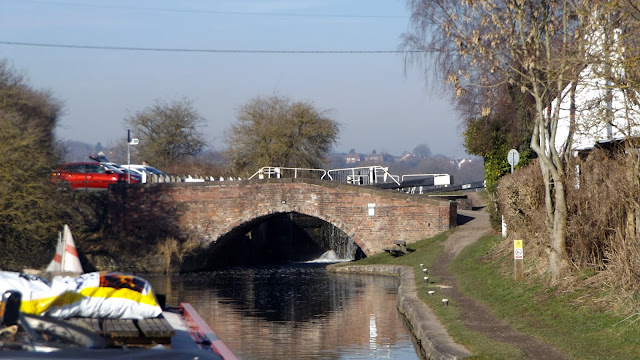It struck me that the lock numbering was a bit odd; this final lock, Langley Mill Lock, is Lock 14. However there are 14 others coming up from Trent Lock… Then it occurred to me that the penultimate lock we came up yesterday was Lock 73. Eastwood Lock.
Hmm… further investigation required.
Looking at the junction from the road bridge crossing.

Langley Mill Lock is in the foreground, straight ahead runs the Cromford Canal and to the right, passing under a swing bridge, is the Nottingham Canal.
A little bit of mooching through maps shows that the Erewash Canal lock numbering is a continuation of that of the Leicester Line. Watford Bottom Lock is Lock 1. So I guess these locks must have been renumbered following the absorption into the Grand Union Canal network in the 1930s. That sorts that out.
And the reason that Langley Mill Lock is number 14 is that it’s not actually on the Erewash, it’s the bottom lock of the 14 fetching the Cromford Canal down from Cromford near Matlock.
Up until the construction of the Cromford, the Erewash finished below the road bridge, in a complex of wharfs off to the left of the existing line. These are now filled in and lost beneath a road junction and Lidl’s carpark.

The Nottingham Canal was opened in 1796, joining the Cromford which opened two years earlier. A stop lock was constructed, with a toll house alongside to control traffic to and from the new navigation. It ran from here to the Trent at Meadow Lane Lock. The company intended to construct a branch to the river above Trent Bridge at Beeston, but this was later built by the Trent Navigation Company. The navigation made money, not spectacularly but steadily until the middle of the 19th century when railway competition forced the canal company to cut their losses, selling to the Amber, Nottingham, Boston and Eastern Junction Railway Company. This later became part of the Great Northern Railway, hence the name of the basin and the pub at the north end of the canal.
Looking down on the Great Northern Basin from the road bridge.

The canal has been filled on the other side of the road, the route now forming a footpath.

Walking back “uphill” past the lock, the footpath follows the Cromford for about a quarter mile, before ending abruptly at a dam. This short navigable stub is used for moorings and is the base for Langley Mill Boatyard.

Beyond the dam restoration work is underway, with the ultimate goal of reopening the canal sometime in the future.

There’s a lot more information on the Erewash Canal Preservation and Development Association website here… The Cromford Canal restoration society’s website is here.
We’re going to reverse to the boatyard in the morning for coal and diesel, top up the water tank then set off back down to the Trent. Taking our time as usual.
Locks 0, miles 0












































